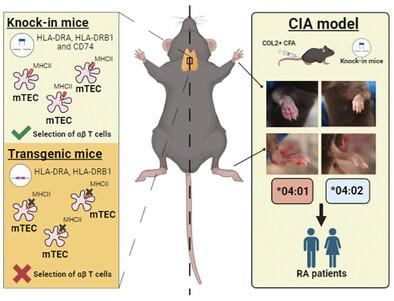Our official English website, www.x-mol.net, welcomes your feedback! (Note: you will need to create a separate account there.)
Human MHC Class II and Invariant Chain Knock‐in Mice Mimic Rheumatoid Arthritis with Allele Restriction in Immune Response and Arthritis Association
Advanced Science ( IF 15.1 ) Pub Date : 2024-04-11 , DOI: 10.1002/advs.202401513 Laura Romero‐Castillo 1 , Taotao Li 1 , Nhu‐Nguyen Do 1, 2 , Outi Sareila 1, 3 , Bingze Xu 1 , Viktoria Hennings 4 , Zhongwei Xu 1 , Carolin Svensson 1 , Ana Oliveira‐Coelho 1 , Zeynep Sener 1 , Vilma Urbonaviciute 1 , Olov Ekwall 4 , Harald Burkhardt 2, 5 , Rikard Holmdahl 1, 3
Advanced Science ( IF 15.1 ) Pub Date : 2024-04-11 , DOI: 10.1002/advs.202401513 Laura Romero‐Castillo 1 , Taotao Li 1 , Nhu‐Nguyen Do 1, 2 , Outi Sareila 1, 3 , Bingze Xu 1 , Viktoria Hennings 4 , Zhongwei Xu 1 , Carolin Svensson 1 , Ana Oliveira‐Coelho 1 , Zeynep Sener 1 , Vilma Urbonaviciute 1 , Olov Ekwall 4 , Harald Burkhardt 2, 5 , Rikard Holmdahl 1, 3
Affiliation

|
Transgenic mice expressing human major histocompatibility complex class II (MHCII) risk alleles are widely used in autoimmune disease research, but limitations arise due to non‐physiologic expression. To address this, physiologically relevant mouse models are established via knock‐in technology to explore the role of MHCII in diseases like rheumatoid arthritis. The gene sequences encoding the ectodomains are replaced with the human DRB1*04:01 and 04:02 alleles, DRA, and CD74 (invariant chain) in C57BL/6N mice. The collagen type II (Col2a1 ) gene is modified to mimic human COL2. Importantly, DRB1*04:01 knock‐in mice display physiologic expression of human MHCII also on thymic epithelial cells, in contrast to DRB1*04:01 transgenic mice. Humanization of the invariant chain enhances MHCII expression on thymic epithelial cells, increases mature B cell numbers in spleen, and improves antigen presentation. To validate its functionality, the collagen‐induced arthritis (CIA) model is used, where DRB1*04:01 expression led to a higher susceptibility to arthritis, as compared with mice expressing DRB1*04:02. In addition, the humanized T cell epitope on COL2 allows autoreactive T cell‐mediated arthritis development. In conclusion, the humanized knock‐in mouse faithfully expresses MHCII, confirming the DRB1*04:01 alleles role in rheumatoid arthritis and being also useful for studying MHCII‐associated diseases.
中文翻译:

人类 MHC II 类和不变链敲入小鼠模拟类风湿性关节炎,免疫反应和关节炎关联中等位基因限制
表达人类主要组织相容性复合体 II 类 (MHCII) 风险等位基因的转基因小鼠广泛用于自身免疫性疾病研究,但由于非生理表达而产生局限性。为了解决这个问题,通过敲入技术建立了生理相关的小鼠模型,以探索 MHCII 在类风湿关节炎等疾病中的作用。在 C57BL/6N 小鼠中,编码胞外域的基因序列被人 DRB1*04:01 和 04:02 等位基因、DRA 和 CD74(不变链)取代。 II 型胶原蛋白(列2a1 ) 基因经过修饰以模仿人类 COL2。重要的是,与 DRB1*04:01 转基因小鼠相比,DRB1*04:01 敲入小鼠在胸腺上皮细胞上也显示出人类 MHCII 的生理表达。恒定链的人源化增强了胸腺上皮细胞上的 MHCII 表达,增加了脾脏中成熟 B 细胞的数量,并改善了抗原呈递。为了验证其功能,使用了胶原诱导关节炎 (CIA) 模型,其中与表达 DRB1*04:02 的小鼠相比,DRB1*04:01 表达导致对关节炎的易感性更高。此外,COL2 上的人源化 T 细胞表位允许自身反应性 T 细胞介导的关节炎发生。总之,人源化敲入小鼠忠实地表达 MHCII,证实了 DRB1*04:01 等位基因在类风湿性关节炎中的作用,也可用于研究 MHCII 相关疾病。
更新日期:2024-04-11
中文翻译:

人类 MHC II 类和不变链敲入小鼠模拟类风湿性关节炎,免疫反应和关节炎关联中等位基因限制
表达人类主要组织相容性复合体 II 类 (MHCII) 风险等位基因的转基因小鼠广泛用于自身免疫性疾病研究,但由于非生理表达而产生局限性。为了解决这个问题,通过敲入技术建立了生理相关的小鼠模型,以探索 MHCII 在类风湿关节炎等疾病中的作用。在 C57BL/6N 小鼠中,编码胞外域的基因序列被人 DRB1*04:01 和 04:02 等位基因、DRA 和 CD74(不变链)取代。 II 型胶原蛋白(



























 京公网安备 11010802027423号
京公网安备 11010802027423号